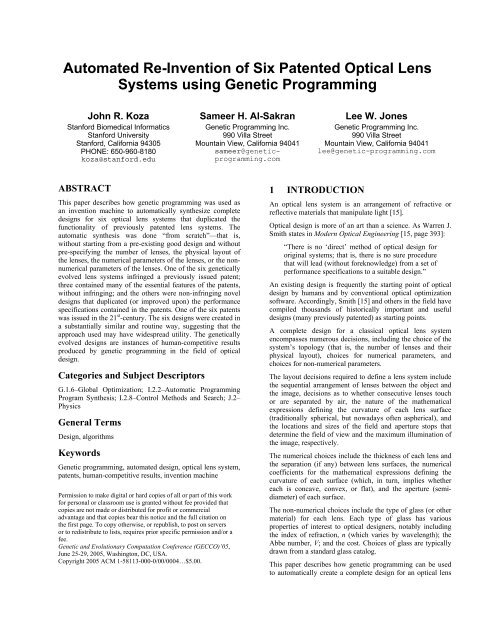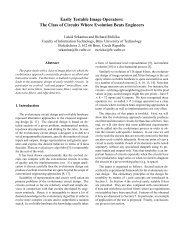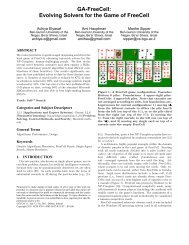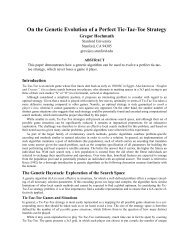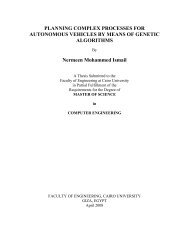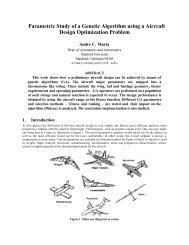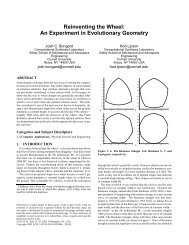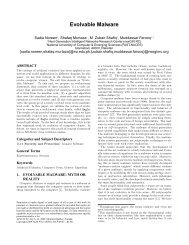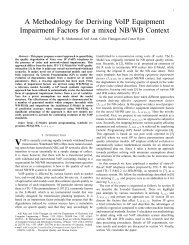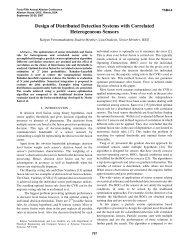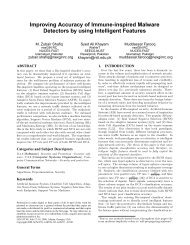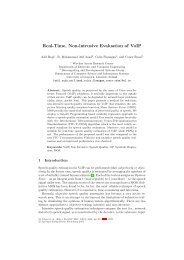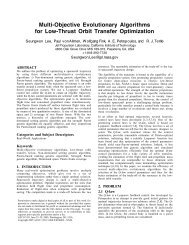Automated Re-Invention of Six Patented Optical Lens Systems using ...
Automated Re-Invention of Six Patented Optical Lens Systems using ...
Automated Re-Invention of Six Patented Optical Lens Systems using ...
You also want an ePaper? Increase the reach of your titles
YUMPU automatically turns print PDFs into web optimized ePapers that Google loves.
<strong>Automated</strong> <strong>Re</strong>-<strong>Invention</strong> <strong>of</strong> <strong>Six</strong> <strong>Patented</strong> <strong>Optical</strong> <strong>Lens</strong><br />
<strong>Systems</strong> <strong>using</strong> Genetic Programming<br />
John R. Koza<br />
Stanford Biomedical Informatics<br />
Stanford University<br />
Stanford, California 94305<br />
PHONE: 650-960-8180<br />
koza@stanford.edu<br />
Sameer H. Al-Sakran<br />
Genetic Programming Inc.<br />
990 Villa Street<br />
Mountain View, California 94041<br />
sameer@geneticprogramming.com<br />
Lee W. Jones<br />
Genetic Programming Inc.<br />
990 Villa Street<br />
Mountain View, California 94041<br />
lee@genetic-programming.com<br />
ABSTRACT<br />
This paper describes how genetic programming was used as<br />
an invention machine to automatically synthesize complete<br />
designs for six optical lens systems that duplicated the<br />
functionality <strong>of</strong> previously patented lens systems. The<br />
automatic synthesis was done “from scratch”—that is,<br />
without starting from a pre-existing good design and without<br />
pre-specifying the number <strong>of</strong> lenses, the physical layout <strong>of</strong><br />
the lenses, the numerical parameters <strong>of</strong> the lenses, or the nonnumerical<br />
parameters <strong>of</strong> the lenses. One <strong>of</strong> the six genetically<br />
evolved lens systems infringed a previously issued patent;<br />
three contained many <strong>of</strong> the essential features <strong>of</strong> the patents,<br />
without infringing; and the others were non-infringing novel<br />
designs that duplicated (or improved upon) the performance<br />
specifications contained in the patents. One <strong>of</strong> the six patents<br />
was issued in the 21 st -century. The six designs were created in<br />
a substantially similar and routine way, suggesting that the<br />
approach used may have widespread utility. The genetically<br />
evolved designs are instances <strong>of</strong> human-competitive results<br />
produced by genetic programming in the field <strong>of</strong> optical<br />
design.<br />
Categories and Subject Descriptors<br />
G.1.6–Global Optimization; I.2.2–Automatic Programming<br />
Program Synthesis; I.2.8–Control Methods and Search; J.2–<br />
Physics<br />
General Terms<br />
Design, algorithms<br />
Keywords<br />
Genetic programming, automated design, optical lens system,<br />
patents, human-competitive results, invention machine<br />
Permission to make digital or hard copies <strong>of</strong> all or part <strong>of</strong> this work<br />
for personal or classroom use is granted without fee provided that<br />
copies are not made or distributed for pr<strong>of</strong>it or commercial<br />
advantage and that copies bear this notice and the full citation on<br />
the first page. To copy otherwise, or republish, to post on servers<br />
or to redistribute to lists, requires prior specific permission and/or a<br />
fee.<br />
Genetic and Evolutionary Computation Conference (GECCO)’05,<br />
June 25-29, 2005, Washington, DC, USA.<br />
Copyright 2005 ACM 1-58113-000-0/00/0004…$5.00.<br />
1 INTRODUCTION<br />
An optical lens system is an arrangement <strong>of</strong> refractive or<br />
reflective materials that manipulate light [15].<br />
<strong>Optical</strong> design is more <strong>of</strong> an art than a science. As Warren J.<br />
Smith states in Modern <strong>Optical</strong> Engineering [15, page 393]:<br />
“There is no ‘direct’ method <strong>of</strong> optical design for<br />
original systems; that is, there is no sure procedure<br />
that will lead (without foreknowledge) from a set <strong>of</strong><br />
performance specifications to a suitable design.”<br />
An existing design is frequently the starting point <strong>of</strong> optical<br />
design by humans and by conventional optical optimization<br />
s<strong>of</strong>tware. Accordingly, Smith [15] and others in the field have<br />
compiled thousands <strong>of</strong> historically important and useful<br />
designs (many previously patented) as starting points.<br />
A complete design for a classical optical lens system<br />
encompasses numerous decisions, including the choice <strong>of</strong> the<br />
system’s topology (that is, the number <strong>of</strong> lenses and their<br />
physical layout), choices for numerical parameters, and<br />
choices for non-numerical parameters.<br />
The layout decisions required to define a lens system include<br />
the sequential arrangement <strong>of</strong> lenses between the object and<br />
the image, decisions as to whether consecutive lenses touch<br />
or are separated by air, the nature <strong>of</strong> the mathematical<br />
expressions defining the curvature <strong>of</strong> each lens surface<br />
(traditionally spherical, but nowadays <strong>of</strong>ten aspherical), and<br />
the locations and sizes <strong>of</strong> the field and aperture stops that<br />
determine the field <strong>of</strong> view and the maximum illumination <strong>of</strong><br />
the image, respectively.<br />
The numerical choices include the thickness <strong>of</strong> each lens and<br />
the separation (if any) between lens surfaces, the numerical<br />
coefficients for the mathematical expressions defining the<br />
curvature <strong>of</strong> each surface (which, in turn, implies whether<br />
each is concave, convex, or flat), and the aperture (semidiameter)<br />
<strong>of</strong> each surface.<br />
The non-numerical choices include the type <strong>of</strong> glass (or other<br />
material) for each lens. Each type <strong>of</strong> glass has various<br />
properties <strong>of</strong> interest to optical designers, notably including<br />
the index <strong>of</strong> refraction, n (which varies by wavelength); the<br />
Abbe number, V; and the cost. Choices <strong>of</strong> glass are typically<br />
drawn from a standard glass catalog.<br />
This paper describes how genetic programming can be used<br />
to automatically create a complete design for an optical lens
system. The automatic synthesis is done “from scratch”—that<br />
is, without starting from a pre-existing good design and<br />
without pre-specifying the number <strong>of</strong> lenses, the physical<br />
layout <strong>of</strong> the lenses, the numerical parameters <strong>of</strong> the lenses,<br />
or the non-numerical parameters <strong>of</strong> the lenses.<br />
Section 2 mentions previous work. Section 3 provides<br />
background on the design <strong>of</strong> optical lens systems. Section 4<br />
discusses the preparatory steps used to apply genetic<br />
programming to optical systems. Section 5 presents the<br />
results. Section 6 is the conclusion.<br />
2 PREVIOUS WORK<br />
Genetic algorithms have been extensively used for optimizing<br />
the choices <strong>of</strong> parameters <strong>of</strong> optical systems with a prespecified<br />
layout and pre-specified number <strong>of</strong> lenses, as listed<br />
in Jarmo Alander’s An Indexed Bibliography <strong>of</strong> Genetic<br />
Algorithms in Optics and Image Processing [1].<br />
In a noteworthy paper, Beaulieu, Gagné, and Parizeau [3]<br />
used genetic programming to “re-engineer” the design <strong>of</strong> a<br />
four-lens system (itself produced by a run <strong>of</strong> the genetic<br />
algorithm) and thereby create an improvement over the best<br />
design produced by 11 human teams in a design competition<br />
held at the 1990 International <strong>Lens</strong> Design Conference. Their<br />
approach used functions that incrementally adjusted<br />
(additively or multiplicatively) the distance between lens<br />
surfaces, radius <strong>of</strong> curvature <strong>of</strong> lens surfaces, and stop<br />
location values.<br />
Our group recently used genetic programming to create an<br />
optical lens system “from scratch”—without starting from a<br />
pre-existing good design and without pre-specifying the<br />
number <strong>of</strong> lenses, the physical layout <strong>of</strong> the lenses, or the<br />
numerical parameters <strong>of</strong> the lenses [2].<br />
3 BACKGROUND ON THE DESIGN<br />
OF OPTICAL LENS SYSTEMS<br />
A classical lens system is conventionally specified by a table<br />
called a prescription (or, if the system is being analyzed by<br />
modern-day optical simulation s<strong>of</strong>tware, a lens file). Table 1<br />
shows a prescription for the patented Tackaberry-Muller lens<br />
system [16] <strong>of</strong> figure 1. See a general textbook on optics [15]<br />
or our recently published paper [2] for a detailed explanation<br />
<strong>of</strong> a prescription (such as table 1).<br />
a<br />
b<br />
c<br />
e<br />
d<br />
1 2 3 4 5 6 7<br />
Object Entry Pupil Image<br />
Figure 1 The Tackaberry-Muller lens system<br />
Once a classical optical system is specified by means <strong>of</strong> its<br />
prescription (lens file), many <strong>of</strong> its optical properties can be<br />
calculated by tracing the path <strong>of</strong> light rays <strong>of</strong> various<br />
wavelengths through the system. Ray-tracing analysis by<br />
hand is extremely time-consuming. Ray tracing is typically<br />
performed nowadays by optical simulation s<strong>of</strong>tware (e.g.,<br />
f<br />
OSLO, Zemax, Code V, KOJAC). Figure 2 shows three (<strong>of</strong><br />
the many) conventional curves presenting characteristics <strong>of</strong><br />
interest to optical designers, including distortion (figure 2a),<br />
astigmatism (figure 2b), and chromatic aberration (figure 2c)<br />
for the Tackaberry-Muller system.<br />
Table 1 <strong>Lens</strong> file for Tackaberry-Muller system<br />
Surface Distance Radius Material Aperture<br />
Object 10 10 flat air<br />
Entry 0.88 flat air 0.18<br />
pupil<br />
1 0.21900 –3.5236 BK7 0.62<br />
2 0.07280 –1.0527 air 0.62<br />
3 0.22500 –4.4072 BK7 0.62<br />
4 0.01360 –1.0704 air 0.62<br />
5 0.52100 1.02491 BK7 0.62<br />
6 0.11800 –0.9349 SF61 0.62<br />
7 0.47485 7.94281 air 0.62<br />
Image<br />
flat<br />
Distortion<br />
5.0<br />
-5.0<br />
Aperture<br />
1<br />
Aperture<br />
1<br />
-0.05 0.05<br />
Astigmatism<br />
(a) (b) (c)<br />
Wavelength<br />
0.7<br />
0.6<br />
0.5<br />
-0.02 0.02<br />
Chromatic Aberration<br />
Figure 2 Distortion, astigmatism, and chromatic<br />
aberration <strong>of</strong> the Tackaberry-Muller system<br />
Figure 3 shows the on-axis ray intercept diagram (figure 3a)<br />
and the full-field ray intercept diagram (figure 3b) for the<br />
Tackaberry-Muller system. Each <strong>of</strong> these diagrams has two<br />
parts, with the diagram for the meridional plane on the left<br />
and the sagittal on the right. In addition, a similar pair <strong>of</strong><br />
figures is typically derived for a partial-field ray intercept.<br />
-1<br />
(a)<br />
Aberration 0.02<br />
-0.02<br />
Aperature<br />
1<br />
0.02<br />
Aberration<br />
-0.02<br />
Aperature<br />
1<br />
-1<br />
(b)<br />
Aberration 0.02<br />
-0.02<br />
Aperature<br />
1<br />
0.02<br />
Aberration<br />
-0.02<br />
Aperature<br />
1<br />
Figure 3 On-axis and full-field ray intercept diagrams for<br />
the Tackaberry-Muller system<br />
4 PREPARATORY STEPS<br />
We now describe our representation scheme (including our<br />
developmental process and function set), the fitness<br />
calculation for one <strong>of</strong> the six lens systems discussed herein<br />
(the others being similar), and the two domain-specific<br />
mutation operations that we used. Other details are in [2] and<br />
the technical report (available on the web) cited therein.
4.1 <strong>Re</strong>presentation Scheme<br />
The widely-used and well-established format for optical<br />
prescriptions (and lens files for optical analysis s<strong>of</strong>tware)<br />
suggests the developmental process [17, 5] for representing<br />
candidate individuals in the population.<br />
Our developmental representation employs a turtle similar to<br />
the turtle used in Lindenmayer systems [11], the LOGO<br />
programming language, and our previous work <strong>using</strong> genetic<br />
programming to synthesize geometric patterns [8] and<br />
antennas [4]. The turtle starts at the point (point e in figures 1<br />
and 4) where the system’s main axis (line b in figures 1 and<br />
4) intersects with the entry pupil surface.<br />
The three-argument SS (“spherical surface”) function causes<br />
the turtle to do three things at its starting point (and each<br />
subsequent point to which the turtle moves). First, it inserts a<br />
spherical surface with a specified radius <strong>of</strong> curvature at the<br />
turtle’s present location. Second, the SS function moves the<br />
turtle to the right by a specified distance along the system’s<br />
main axis. Third, the SS function fills the space to the right<br />
<strong>of</strong> the just-added surface with a specified type <strong>of</strong> material.<br />
Figure 4 shows the result <strong>of</strong> the insertion <strong>of</strong> spherical surface<br />
1 (with a radius <strong>of</strong> curvature <strong>of</strong> –3.52361). After inserting this<br />
surface, the turtle moves the specified distance <strong>of</strong> 0.219 from<br />
its starting point g to point h along axis line b. The “BK7” in<br />
the figure indicates that glass <strong>of</strong> type BK7 (a commercially<br />
available crown glass) will be used to fill the space between g<br />
and whatever surface is inserted at point h (by the turtle’s<br />
next step). These actions by the turtle reflect the information<br />
contained on row “1” <strong>of</strong> the prescription (table 1).<br />
b<br />
e<br />
g h<br />
BK7<br />
1<br />
Object Entry Pupil Image<br />
Figure 4 Turtle moves from g to h and inserts surface 1<br />
Figure 5 shows the result <strong>of</strong> the insertion by the turtle <strong>of</strong><br />
spherical surface 2 (with a radius <strong>of</strong> curvature <strong>of</strong> –1.05274).<br />
After inserting this surface, the turtle moves the specified<br />
distance <strong>of</strong> 0.07280 from point h to i. Surfaces 1 and 2<br />
together define a lens <strong>of</strong> thickness 0.219 <strong>of</strong> BK7 glass. Note<br />
that the material inserted to the right <strong>of</strong> surface 2 is air. That<br />
is, air will be used to fill the space between h and whatever<br />
surface is inserted at point i (by the turtle’s next step). These<br />
actions reflect row “2” <strong>of</strong> the prescription (table 1).<br />
b<br />
e<br />
g h i<br />
BK7 AIR<br />
1 2<br />
Object Entry Pupil Image<br />
Figure 5 Turtle moves from h to i and inserts surface 2<br />
f<br />
f<br />
Radius and distance values are each established by valuesetting<br />
subtrees <strong>of</strong> the SS function consisting <strong>of</strong> a single<br />
perturbable numerical value. The material is established by a<br />
value-setting subtree consisting <strong>of</strong> a terminal identifying the<br />
type <strong>of</strong> material (e.g., air, BK7).<br />
The turtle can similarly create a free-standing second lens<br />
(surfaces 3 and 4 in figure 1) and an additional lens (surfaces<br />
5 and 6 in figure 1). The doublet lens (surfaces 6 and 7 <strong>of</strong><br />
figure 1) is then created by inserting SK4 glass (instead <strong>of</strong> air)<br />
to the right <strong>of</strong> surface 6.<br />
The two-argument PROGN2 function is a connective<br />
function that first executes its first argument and then<br />
executes its second argument.<br />
A constrained syntactic structure specifies how the functions<br />
and terminals may be combined in a program tree. The<br />
constrained syntactic structure enforces the use <strong>of</strong> one<br />
terminal set (containing perturbable numerical values) for<br />
each value-setting subtree that establishes the numerical value<br />
for thickness and radius <strong>of</strong> curvature; another terminal set for<br />
establishing the type <strong>of</strong> material (containing symbolic values<br />
changeable by our glass mutation operation described below);<br />
and another function set for all other parts <strong>of</strong> the program<br />
tree. The constrained syntactic structure further specifies that<br />
the top-most function in a program tree is a PROGN2<br />
function (to avoid trees that construct only a single surface).<br />
The object surface (OBJ), image surface (IMS) and entry<br />
pupil (EP) together constitute a test fixture that is directly<br />
analogous to the test fixtures used in connection with the<br />
automatic synthesis <strong>of</strong> electrical circuits by means <strong>of</strong> genetic<br />
programming [9, 10].<br />
4.2 Fitness Measure<br />
The fitness measure used in the field <strong>of</strong> optical design<br />
(whether by evolutionary search or human design) is multiobjective<br />
in the sense that it contains numerous elements.<br />
We developed our own lens analysis simulator based on<br />
KOJAC, a public-domain educational s<strong>of</strong>tware package for<br />
optical ray tracing originally authored by Olivier Scherler and<br />
currently maintained by Olivier Ripoll, to evaluate the<br />
performance <strong>of</strong> candidate lens systems. We wrote code to use<br />
the ray traces produced by KOJAC to compute relevant<br />
optical characteristics and additionally wrote code for the<br />
image analysis. We embedded all <strong>of</strong> this code in our genetic<br />
programming system operating on our Beowulf cluster<br />
computer. We used a commercially available s<strong>of</strong>tware<br />
package (OSLO from Lambda <strong>Re</strong>search) running on a single<br />
workstation for post-run validation <strong>of</strong> final results.<br />
The fitness measure begins by analyzing an axial and chief<br />
ray trace in order to derive aberration and paraxial<br />
coefficients (and assigns a fatally high penalty value if either<br />
ray trace fails). Fitness is incremented by the weighted sum <strong>of</strong><br />
the deviations between the behavior <strong>of</strong> the candidate<br />
individual and the target values <strong>of</strong> various performance<br />
measures. In particular, fitness is incremented by the sum <strong>of</strong><br />
1,000 times each <strong>of</strong> the following aberration deviations:<br />
spherical aberration, astigmatism, distortion, coma, axial<br />
chromatic, lateral chromatic; 100 times the absolute deviation<br />
<strong>of</strong> effective focal length (EFL) from target; 100 times the<br />
absolute deviation <strong>of</strong> back focal length (BFL) from target (but<br />
only if it is less than target); and 25 times the absolute
deviation <strong>of</strong> Petzval radius from target (but only if it is less<br />
than target). The weights were chosen to approximately<br />
equalize the influence <strong>of</strong> each <strong>of</strong> the above types <strong>of</strong><br />
deviations in a manner similar to our recent work with<br />
automatic circuit systems involving multi-objective fitness<br />
measures.<br />
Then, a 17×17 grid is overlaid on the entry pupil and a ray is<br />
shot through the corner defining each grid position contained<br />
inside the entry pupil.<br />
Figures 6a, 6b, and 6c are gray scale versions <strong>of</strong> a three-color<br />
spot diagram for the Tackaberry-Muller system. The rays<br />
from figure 6 are traced for each <strong>of</strong> three wavelengths (486,<br />
588 and 656 nm) and projected through the system onto the<br />
image plane. Figure 6a shows the trace from the axial point.<br />
Figure 6b shows the trace from the 70% <strong>of</strong> the field <strong>of</strong> view<br />
(FOV). Figure 6c shows the full FOV performance. Figure 6d<br />
shows the modulation transfer function performance <strong>of</strong> the<br />
Tackaberry-Muller system in the tangential and sagittal<br />
planes <strong>of</strong> each <strong>of</strong> the FOV positions.<br />
The spot diagram measures the deviation resulting from the<br />
compound error <strong>of</strong> the chosen lens aberration contributions.<br />
An ideal diffraction limit spot size (corresponding to the<br />
minimum spot size that can be discernable when diffraction<br />
effects are taken into account) is determined for the system<br />
and the root mean square (RMS) error for the ray intercept<br />
deviations is calculated. Fitness is incremented by 200, 340<br />
and 400 times the difference between the target RMS error<br />
for the axial, 70% FOV and full FOV, respectively. The<br />
increasing penalty multiplier reflects the increasing difficulty<br />
in attaining the desired performance. The modulation transfer<br />
functions measure the contrast and resolution differences<br />
between the object and the image. Each curve is sampled at<br />
30 increments <strong>of</strong> 10 cycles/mm across the target system and<br />
that modulation efficiency is defined as the target to meet.<br />
After an individual reaches a specified satisfactory level for<br />
all <strong>of</strong> the foregoing requirements, individuals are evaluated<br />
for parsimony. The parsimony penalty is the sum <strong>of</strong> 100 times<br />
the number <strong>of</strong> lenses, 100 times the number <strong>of</strong> different types<br />
<strong>of</strong> glass used, the width <strong>of</strong> the lens system (its footprint), and<br />
(optionally, but not used for the work in this paper) the cost<br />
<strong>of</strong> the glass (found in the glass catalog).<br />
(a) (b) (c) (d)<br />
Figure 6 Fitness measure<br />
Modulation<br />
1<br />
0.8<br />
0.6<br />
0.4<br />
0.2<br />
0<br />
60 120 180 240 300<br />
Spatial Frequency<br />
For the specific problem discussed herein, each candidate lens<br />
system is first examined to see if it is “all air.” If so, the<br />
individual receives a fatally high penalty value <strong>of</strong> fitness. In<br />
addition, a significant (but not fatal) infeasibility penalty is<br />
applied if the back focal length (BFL) is negative (meaning<br />
the image is inside the lens system, instead <strong>of</strong> being to the<br />
right), or if the final surface is not air (meaning that a flat<br />
glass surface touches the image surface).<br />
4.3 Toroidal Mutation for Curvatures<br />
Because a flat surface can be viewed as a spherical surface<br />
with a very large positive or negative radius <strong>of</strong> curvature, our<br />
mutation operation operates in a toroidal way when it is<br />
applied to a terminal representing the radius <strong>of</strong> curvature.<br />
4.4 Glass Mutation<br />
In real-world situations, the optical designer usually chooses<br />
one <strong>of</strong> a relatively small number <strong>of</strong> commercially available<br />
types <strong>of</strong> glass (such as those found in the Schott catalog).<br />
Accordingly, we used a domain-specific mutation operation<br />
that permits mutation only to a “nearby” type <strong>of</strong> glass (in the<br />
multidimensional property space) in the chosen catalog.<br />
4.5 Control Parameters<br />
The population size was approximately 75,000 (500<br />
individuals per node and slightly more or less than 150 nodes<br />
for each <strong>of</strong> the six problems discussed in this paper). Because<br />
there is only one active function (SS), all <strong>of</strong> its arguments are<br />
terminals, and the glass mutation operator is unusually<br />
important, we performed crossover, numerical mutation, and<br />
glass mutation at 30% probability each, with reproduction at<br />
9% and tree mutation at 1%.<br />
5 RESULTS<br />
We applied the above techniques to six patented eyepieces:<br />
● the 1940 Konig patent [7],<br />
● the 1953 Ludewig patent [12],<br />
● the 1958 Tackaberry-Muller patent [16],<br />
● the 1968 Scidmore patent [14],<br />
● the 1985 Nagler patent [13], and<br />
● the 2000 Koizumi-Watanabe patent [6].<br />
Each patent states the inventor’s high-level design goals, a<br />
detailed specification <strong>of</strong> the invention, one or more<br />
independent claims (usually with an associated prescription)<br />
and a diagram <strong>of</strong> the optical lens system. We present a<br />
complete set <strong>of</strong> information for all six patented lens systems<br />
in our detailed technical report available on the web [14]. We<br />
show a diagram for all six patented lens systems and a<br />
diagram for all six genetically evolved systems in this paper.<br />
However, because <strong>of</strong> space limitations, we present only a<br />
sampling <strong>of</strong> the other information contained in the technical<br />
report in this paper. For example, we show the prescription<br />
for the patented system only for the Tackaberry-Muller (see<br />
table 1) and we briefly describe the fitness measure used in<br />
the run <strong>of</strong> genetic programming only for the Tackaberry-<br />
Muller system (see section 4.2). We show the prescription for<br />
two <strong>of</strong> the six genetically evolved results.<br />
As will be seen, one <strong>of</strong> the six genetically evolved lens<br />
systems infringed a previously issued patent; one was very<br />
close to infringing (the one small numerical difference<br />
apparently being due to the fact that the genetically evolved<br />
individual was an improvement on the design goals stated in<br />
the patent); three contained many <strong>of</strong> the essential features <strong>of</strong><br />
the patents without infringing; and the others were noninfringing<br />
novel designs that duplicated (or improved upon)<br />
the performance specifications contained in the patents.
5.1 Ludewig Eyepiece<br />
Figure 7 shows the patented Ludewig lens system [12].<br />
a<br />
b<br />
c<br />
d<br />
1 2 3 4 5 6 7 8 9<br />
Object Entry Pupil Image<br />
Figure 7 Ludewig patent<br />
Figure 8 shows the best-<strong>of</strong>-run lens system created by our run<br />
<strong>of</strong> genetic programming in generation 257 on the Ludewig<br />
problem and table 2 shows the prescription (lens file) for this<br />
best-<strong>of</strong>-run individual. As can be seen, the genetically<br />
evolved system is similar to the patented Ludewig system in<br />
that it has the same number <strong>of</strong> lenses, surfaces, and multi-part<br />
lenses (one doublet and three singlet lenses); however, the<br />
genetically evolved system is slightly different in detail.<br />
a<br />
b<br />
c<br />
d<br />
1 2 3 4 5 6 7 8 9<br />
Object Entry Pupil Image<br />
Figure 8 Best-<strong>of</strong>-run lens system from generation 257 for<br />
the Ludewig problem<br />
Table 2 <strong>Lens</strong> file for the best-<strong>of</strong>-run individual from<br />
generation 257 for the Ludewig problem<br />
Surface Distance Radius Material Aperture<br />
OBJ 10 10 flat air<br />
EP 0.7805 flat air 0.2<br />
2 0.13795 -5.57235 SF58 0.67183<br />
3 0.47498 3.878076 LASFN31 0.67183<br />
4 0.27378 -1.79665 air 0.67183<br />
5 0.15277 10.6411 SK51 0.67183<br />
6 0.1905 -1.95551 air 0.67183<br />
7 0.64411 1.240546 LAK23 0.67183<br />
8 0.14101 -11.7773 air 0.67183<br />
9 0.01 -1.99635 LASF36A 0.67183<br />
10 0.19280 2.640905 air 0.67183<br />
IMS flat 0.67183<br />
Table 3 compares nine characteristics <strong>of</strong> the best-<strong>of</strong>-run<br />
individual from generation 257 on the Ludewig problem with<br />
those <strong>of</strong> the patented lens system. As can be seen in table 3,<br />
the best-<strong>of</strong>-run individual is a slight improvement over the<br />
patented Ludewig system [12] in our tested field <strong>of</strong> view<br />
(smaller values being better).<br />
Table 3 Characteristics <strong>of</strong> the best-<strong>of</strong>-run individual from<br />
generation 257 for the Ludewig problem<br />
Ludewig Evolved<br />
Spherical Aberration -0.005591 -0.004989<br />
Coma -0.003188 -0.002905<br />
Astigmatism 0.004033 0.0038897<br />
Petzval -0.005012 -0.004795<br />
Distortion -0.01207 -0.0109947<br />
Distortion Percentage 2.74 2.39<br />
Max Distortion Percentage 2.74 2.39<br />
Axial Chromatic -0.001494 -0.001404<br />
Lateral Chromatic -0.005518 -0.005523<br />
5.2 Koizumi-Watanabe Eyepiece<br />
Figure 9 shows the patented Koizumi-Watanabe lens system<br />
[6].<br />
a<br />
b c<br />
d<br />
1 2 3 4 5 6 7 8 9<br />
Object Entry Pupil Image<br />
Figure 9 Koizumi-Watanabe patent<br />
Figure 10 shows the best-<strong>of</strong>-run lens system created by our<br />
run <strong>of</strong> genetic programming in generation 295 on the<br />
Koizumi-Watanabe problem. As can be seen, the genetically<br />
evolved lens system has the same number <strong>of</strong> lenses as the<br />
patented system.<br />
a<br />
b c<br />
d<br />
1 2 3 4 5 6 7 8<br />
Object Entry Pupil Image<br />
Figure 10 Best-<strong>of</strong>-run lens system from generation 295 for<br />
the Koizumi-Watanabe problem<br />
Table 4 shows the inventors’ design goals, as stated in the<br />
Koizumi-Watanabe patent. The design goals in this problem<br />
emphasized achieving a specific performance <strong>of</strong> aberration<br />
correction while maintaining a distortion level less than 6%<br />
(the perceptible level when in use) with at least a 55° wide<br />
field <strong>of</strong> view. An additional objective was minimizing the<br />
number <strong>of</strong> lenses. The evolved individual maintains the<br />
aberration corrections at the specified field <strong>of</strong> view with<br />
slightly less distortion. The genetically evolved individual<br />
here satisfies the performance and design goals <strong>of</strong> the<br />
problem, <strong>using</strong> a different topology. That is, genetic<br />
programming invented a lens system that duplicated the<br />
functionality <strong>of</strong> the patented invention in a novel way (i.e.,<br />
genetic programming “engineered around” the patent).
Table 4 Design goals <strong>of</strong> the Koizumi-Watanabe patent<br />
Koizumi-Watanabe patent<br />
Wide field <strong>of</strong> view<br />
(specifically, greater than 55<br />
degrees)<br />
Less than 6% distortion<br />
through full field <strong>of</strong> view<br />
Less than six lens elements<br />
Genetically evolved<br />
The field <strong>of</strong> view extends to<br />
65 degrees<br />
5.78% is the max distortion<br />
The evolved individual has<br />
five lenses<br />
Low aberration contributions Evolved individual has<br />
performance equivalent to<br />
patented system<br />
5.3 Nagler Eyepiece<br />
Figure 11 shows the patented Nagler lens system [13]. This<br />
system has four groups <strong>of</strong> lenses.<br />
Table 5 Design goals <strong>of</strong> the Nagler patent<br />
Nagler Patent<br />
Genetically evolved<br />
Very-Wide field <strong>of</strong> view<br />
(>70 degrees)<br />
Field <strong>of</strong> view extends to 70<br />
degrees<br />
<strong>Re</strong>duced Astigmatism at the<br />
edge <strong>of</strong> the field<br />
<strong>Lens</strong> system has very low<br />
astigmatism in image<br />
Low aberration contributions Evolved individual has<br />
equivalent performance to<br />
embodiment<br />
Compact six lens system 10-lenses<br />
5.4 Scidmore Eyepiece<br />
Figure 13 shows the patented Scidmore lens system [14].<br />
a<br />
b<br />
c<br />
d<br />
a<br />
b c<br />
d<br />
1 2 3 4 5 6 7 8 9 10<br />
Object Entry Pupil<br />
Figure 11 Nagler patent<br />
1 2 3 4 5 6 7 8 9 10<br />
Image<br />
Object Entry Pupil Image<br />
Figure 13 Scidmore patent<br />
Figure 14 shows the best-<strong>of</strong>-run lens system created by our<br />
run <strong>of</strong> genetic programming in generation 299 on the<br />
Scidmore problem.<br />
Figure 12 shows the best-<strong>of</strong>-run lens system created by our<br />
run <strong>of</strong> genetic programming in generation 300 on the Nagler<br />
problem. This system has two groups <strong>of</strong> lenses.<br />
a<br />
b<br />
c<br />
d<br />
a<br />
b<br />
c<br />
d<br />
1 2 3 4 5 6 7 8 91011 12<br />
Object Entry Pupil Image<br />
Figure 12 Best-<strong>of</strong>-run lens system from generation 300 for<br />
the Nagler problem<br />
Table 5 shows the inventor’s design goals, as stated in the<br />
patent. The Nagler patent focused on a specific performance<br />
(low astigmatism) at an ultra-wide field <strong>of</strong> view. The<br />
genetically evolved individual used a very different topology<br />
to achieve the specified field <strong>of</strong> view with performance levels<br />
comparable to that <strong>of</strong> the patented system. The patent<br />
specifies a four-group solution consisting <strong>of</strong> a 2-1-1-2 lens<br />
configuration. As seen in figure 12, the evolved individual<br />
uses four additional lenses but compacted into a two-group<br />
solution (with four lenses in one group and six in the other).<br />
1 2 3 4 5 6 7 8 9<br />
Object Entry Pupil Image<br />
Figure 14 Best-<strong>of</strong>-run lens system from generation 299 for<br />
the Scidmore problem<br />
Table 6 shows the inventor’s design goals, as stated in the<br />
Scidmore patent. The focus was on achieving a minimum<br />
acceptable performance level over a wide field-<strong>of</strong>-view and<br />
minimizing the surface count for manufacturing purposes.<br />
Table 6 Design goals <strong>of</strong> the Scidmore patent<br />
Scidmore Patent<br />
Genetically evolved<br />
Very-Wide field <strong>of</strong> view<br />
(>80 degrees)<br />
Field <strong>of</strong> view extends to 80<br />
degrees<br />
Minimize lens elements (six<br />
lens elements in patent)<br />
Evolved individual has six<br />
lens elements<br />
Low aberration contributions Evolved individual has<br />
equivalent performance to<br />
embodiment
The evolved individual achieved the field-<strong>of</strong>-view<br />
specification as well as performance equivalent to that <strong>of</strong> the<br />
patented lens system. As can be seen in figure 14, the evolved<br />
individual also uses one less lens group.<br />
5.5 Konig and Tackaberry-Muller<br />
Eyepiece<br />
The Tackaberry-Muller patent [16] cites the 1940 Konig<br />
patent [7] and is a special case <strong>of</strong> it. The patented Tackaberry-<br />
Muller system is shown in figure 1.<br />
Figure 15 shows the best-<strong>of</strong>-run lens system created by our<br />
run <strong>of</strong> genetic programming in generation 490 on the<br />
Tackaberry-Muller problem.<br />
a<br />
b<br />
c<br />
d<br />
1 2 3 4 5 6 7<br />
Object Entry Pupil Image<br />
Figure 15 Best-<strong>of</strong>-run individual from generation 490 for<br />
the Tackaberry-Muller problem<br />
The only difference (a slightly out-<strong>of</strong>-range radius <strong>of</strong><br />
curvature) between claim 1 <strong>of</strong> the Tackaberry-Muller patent<br />
[16] and the features <strong>of</strong> the best-<strong>of</strong>-run lens system from<br />
generation 490 is apparently due to the improved<br />
performance <strong>of</strong> the genetically evolved design compared to<br />
the patented design [2].<br />
Table 7 shows the lens file for the best-<strong>of</strong>-run individual.<br />
Table 7 <strong>Lens</strong> file for best-<strong>of</strong>-run individual from<br />
generation 490 for the Tackaberry-Muller problem<br />
Surface Distance Radius Material Aperture<br />
OBJ 10 10 flat Air<br />
EP 0.88 flat Air 0.18<br />
1 0.50022 -7.2605 SSK3 0.62<br />
2 0.07953 -1.16406 Air 0.62<br />
3 0.2298 7.5438 SSK3 0.62<br />
4 0.02 -2.5807 Air 0.62<br />
5 0.30591 1.6321 LAK16A 0.62<br />
6 0.2176 -1.3486 SF58 0.62<br />
7 0.5706 8.7356 Air 0.62<br />
IMS<br />
flat<br />
As can be seen in table 8, the best-<strong>of</strong>-run individual is a slight<br />
improvement over the design in the Tackaberry-Muller patent<br />
[16], <strong>using</strong> our fitness measure employing an exact ray trace<br />
<strong>of</strong> the marginal and chief rays for aberration calculations.<br />
Table 9 shows that the best-<strong>of</strong>-run lens system from<br />
generation 490 infringes claim 1 <strong>of</strong> the Konig patent [7].<br />
In summary, one <strong>of</strong> the six genetically evolved lens systems<br />
infringed the previously issued patent and three contained<br />
many <strong>of</strong> the essential features <strong>of</strong> the patents without<br />
infringing. One <strong>of</strong> the six patents was issued in the 21 st -<br />
century.<br />
Table 9 Comparison <strong>of</strong> evolved system to Konig patent<br />
Claim 1 <strong>of</strong> Konig patent<br />
“An optical system for<br />
telescope eyepieces,<br />
comprising a front, a medial<br />
and a rear element, said<br />
elements being convergent<br />
and axially spaced by air,”<br />
“the sum <strong>of</strong> the distances<br />
apart <strong>of</strong> said elements being<br />
at most one-third <strong>of</strong> the<br />
focal length <strong>of</strong> said system,”<br />
“said rear element being a<br />
single lens, the numerical<br />
value <strong>of</strong> the curvature <strong>of</strong> the<br />
rear surface <strong>of</strong> said lens<br />
being smaller than the<br />
numerical value <strong>of</strong> the<br />
refractive power <strong>of</strong> said<br />
lens,”<br />
“said medial element<br />
consisting <strong>of</strong> at least one<br />
lens and at most two<br />
lenses,”<br />
“said front element<br />
consisting <strong>of</strong> at least one<br />
lens,”<br />
“the front lens <strong>of</strong> said<br />
medial element and that lens<br />
<strong>of</strong> said front element which<br />
faces this front lens <strong>of</strong> said<br />
medial element being<br />
convergent,”<br />
“at least one optically<br />
effective surface <strong>of</strong> one <strong>of</strong><br />
said two convergent lenses<br />
being a cemented surface,”<br />
“the refractive power <strong>of</strong> one<br />
cemented surface <strong>of</strong> said<br />
two convergent lenses<br />
amounting to at least eleven<br />
twentieths <strong>of</strong> the algebraic<br />
sum <strong>of</strong> the refractive powers<br />
<strong>of</strong> all cemented surfaces <strong>of</strong><br />
said convergent lenses,”<br />
“the numerical value <strong>of</strong> last<br />
said sum being greater than<br />
one twelfth <strong>of</strong> the sum <strong>of</strong><br />
the numerical values <strong>of</strong> the<br />
curvatures <strong>of</strong> those surfaces<br />
<strong>of</strong> said convergent lenses<br />
which face each other.”<br />
Evolved optical system<br />
The evolved individual<br />
contains three convergent<br />
elements (two single lenses<br />
and one doublet lens) and<br />
they are separated by air.<br />
The focal length <strong>of</strong> the<br />
evolved system is 0.9958 and<br />
the sum <strong>of</strong> the distances is<br />
0.099531 (approximately<br />
1/10).<br />
The curvature <strong>of</strong> the rear<br />
element (the lens defined by<br />
surfaces 1 and 2) is 0.1377<br />
(i.e., 1/7.260474245) and its<br />
refractive power is 0.443518<br />
(computed by the standard<br />
textbook formula).<br />
The medial element (the lens<br />
defined by surfaces 3 and 4) is<br />
a single lens.<br />
The front element (surfaces 5,<br />
6, and 7) consists <strong>of</strong> two<br />
lenses.<br />
These two lenses (namely the<br />
medial lens defined by<br />
surfaces 3 and 4 and the<br />
portion <strong>of</strong> the doublet defined<br />
by surfaces 5 and 6) are both<br />
convergent.<br />
The doublet lens defined by<br />
surfaces 5, 6, and 7 has a<br />
common surface 6.<br />
The refractive power <strong>of</strong> the<br />
specified surface is 0.13652.<br />
It is also the only common<br />
surface and hence amounts to<br />
the entire sum described.<br />
It is equal to 0.136492 which<br />
is greater than one twelfth.
One <strong>of</strong> the eight criteria presented in [9] for saying that an<br />
automatically created result is “human-competitive” is<br />
“The result was patented as an invention in the past,<br />
is an improvement over a patented invention, or<br />
would qualify today as a patentable new invention.”<br />
Based on this definition, we claim that the six genetically<br />
evolved results in this paper are instances <strong>of</strong> “humancompetitive”<br />
results produced by genetic programming.<br />
Table 8 Characteristics <strong>of</strong> the best-<strong>of</strong>-run individual from<br />
generation 490 for the Tackaberry-Muller patent<br />
Tackaberry Evolved<br />
-Muller<br />
Spherical aberration -0.003999 -0.003103<br />
Coma -0.002829 -0.002496<br />
Astigmatism 0.002817 0.002788<br />
Petzval -0.006505 -0.006354<br />
Distortion -0.009907 -0.009244<br />
Distortion percentage 2.4166 1.8344<br />
Maximum distortion 2.4166 1.8344<br />
percentage<br />
Axial chromatic -0.001122 -0.0007371<br />
Lateral chromatic -0.002213 -0.001904<br />
6 CONCLUSION<br />
This paper described how genetic programming was used to<br />
automatically synthesize complete designs for optical lens<br />
systems. The automated synthesis was done “from scratch”—<br />
that is, without starting from a pre-existing good design and<br />
without pre-specifying the number <strong>of</strong> lenses, the physical<br />
layout <strong>of</strong> the lenses, the numerical parameters <strong>of</strong> the lenses,<br />
or the non-numerical parameters <strong>of</strong> the lenses. The evolved<br />
lens systems duplicated the functionality (or infringed) six<br />
patented lens systems, including one 21 st -century patent.<br />
7 ACKNOWLEDGMENTS<br />
Alexander Scheeline <strong>of</strong> the University <strong>of</strong> Illinois made<br />
helpful comments on various versions <strong>of</strong> this work.<br />
8 REFERENCES<br />
1 Alander, Jarmo T. 2000. An Indexed Bibliography <strong>of</strong><br />
Genetic Algorithms in Optics and Image Processing -<br />
Draft August 16, 2000. <strong>Re</strong>port 94-1-OPTICS. Department<br />
<strong>of</strong> Information Technology and Production Economics.<br />
Vassa, Finland: University <strong>of</strong> Vaasa.<br />
2 Al-Sakran, Sameer H., Koza, John R., and Jones, Lee W.<br />
2005. <strong>Automated</strong> re-invention <strong>of</strong> a previously patented<br />
optical lens system <strong>using</strong> genetic programming. In Keijzer,<br />
Maarten, Tettamanzi, Andrea, Collet, Pierre, van Hemert,<br />
Jano, Tomassini, Marco (editor). Genetic Programming:<br />
8th European Conference, EuroGP 2005, Lausanne,<br />
Switzerland, March 30-April 1, 2005, Proceedings.<br />
Lecture Notes in Computer Science 3447. Heidelberg:<br />
Springer-Verlag. Pages 25-37.<br />
3 Beaulieu, Julie, Gagné, Christian, and Parizeau, Marc.<br />
2002. <strong>Lens</strong> system design and re-engineering<br />
experimentations with genetic algorithms and genetic<br />
programming. In Langdon, W. B., Cantu-Paz, E., Mathias,<br />
K., Roy, R., Davis, D., Poli, R., Balakrishnan, K.,<br />
Honavar, V., Rudolph, G., Wegener, J., Bull, L., Potter, M.<br />
A., Schultz, A. C., Miller, J. F., Burke, E., and Jonoska, N.<br />
(editors). Proceedings <strong>of</strong> the 2002 Genetic and<br />
Evolutionary Computation Conference. San Francisco,<br />
CA: Morgan Kaufmann. Pages 155–162.<br />
4 Comisky, William, Yu, Jessen, and Koza, John. 2000.<br />
Automatic synthesis <strong>of</strong> a wire antenna <strong>using</strong> genetic<br />
programming. Late Breaking Papers at the 2000 Genetic<br />
and Evolutionary Computation Conference, Las Vegas,<br />
Nevada. Pages 179–186.<br />
5 Gruau, Frederic. 1992. Cellular Encoding <strong>of</strong> Genetic<br />
Neural Networks. Technical report 92-21. Laboratoire de<br />
l'Informatique du Parallélisme. Ecole Normale Supérieure<br />
de Lyon. May 1992.<br />
6 Koizumi, Noboru and Watanabe, Naomi. 2000. Wide-Field<br />
Eyepiece. U. S. Patent 6,069,750. Filed August 17, 1998.<br />
Issued May 30, 2000.<br />
7 Konig, Albert. 1940. Telescope Eyepiece. U. S. Patent<br />
2,206,195. Filed in Germany December 24, 1937. Filed in<br />
U. S. December 14, 1938. Issued July 2, 1940.<br />
8 Koza, John R. 1993. Discovery <strong>of</strong> rewrite rules in<br />
Lindenmayer systems and state transition rules in cellular<br />
automata via genetic programming. Symposium on Pattern<br />
Formation (SPF-93), Claremont, California. February 13,<br />
1993.<br />
9 Koza, John R., Bennett III, Forrest H, Andre, David, and<br />
Keane, Martin A. 1999. Genetic Programming III:<br />
Darwinian <strong>Invention</strong> and Problem Solving. San Francisco,<br />
CA: Morgan Kaufmann.<br />
10 Koza, John R., Keane, Martin A., Streeter, Matthew J.,<br />
Mydlowec, William, Yu, Jessen, and Lanza, Guido. 2003.<br />
Genetic Programming IV: Routine Human-Competitive<br />
Machine Intelligence. Kluwer Academic Publishers.<br />
11 Prusinkiewicz, Przemyslaw, and Lindenmayer, Aristid.<br />
1990. The Algorithmic Beauty <strong>of</strong> Plants. New York:<br />
Springer-Verlag.<br />
12 Ludewig, Maximillian. 1953. Eyepiece for <strong>Optical</strong><br />
Instruments. U. S. Patent 2,637,245. Filed October 11,<br />
1950. Filed in Germany October 31, 1949.<br />
13 Nagler, Albert. 1985. Wide Angle Eyepiece. U. S. Patent<br />
4,525,035. Filed January 5, 1984. Issued January 25, 1985.<br />
14 Scidmore, Wright H. 1968. Wide Angle Eyepiece. U. S.<br />
Patent 3,390,935. Filed August 9, 1965. Issued July 2,<br />
1968.<br />
15 Smith, Warren J. 2000. Modern <strong>Optical</strong> Engineering. 3 rd<br />
edition. New York: McGraw-Hill.<br />
16 Tackaberry, Robert B. and Muller, Robert M. 1958.<br />
Telescope Eyepiece System. U. S. Patent 2,829,560. Filed<br />
October 15, 1956. Issued April 8, 1958.<br />
17 Wilson, Stewart. W. 1987. The genetic algorithm and<br />
biological development. In Grefenstette, John J.(editor).<br />
Genetic Algorithms and Their Applications: Proceedings<br />
<strong>of</strong> the Second International Conference on Genetic<br />
Algorithms. Hillsdale, NJ: Lawrence Erlbaum Associates.<br />
Pages 247-251.


